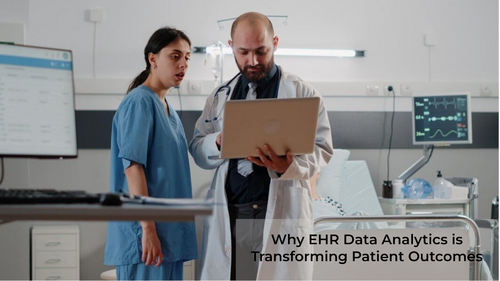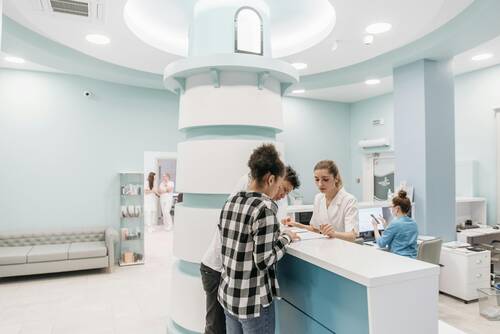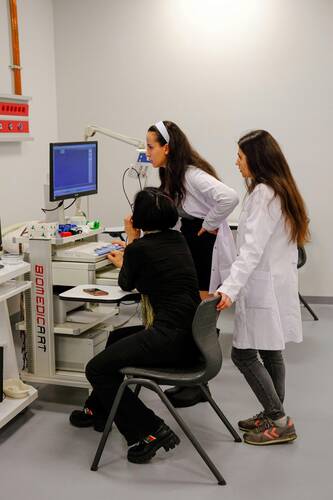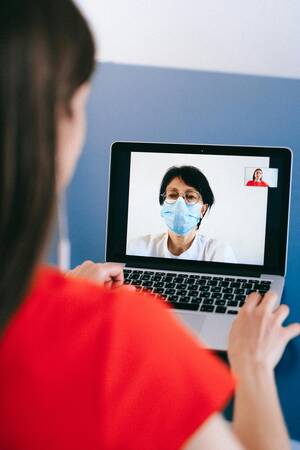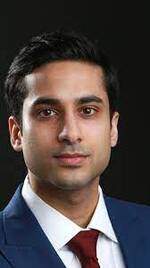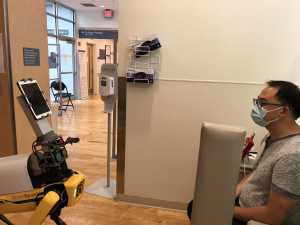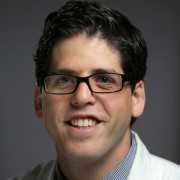Aside from patient care on an individual basis, EHR data analytics also revolutionizes population health management. Through the review of...
AI note-taking tools can capture patient information during consultations and automatically synchronize it with EHR systems. This eliminates the need...
Electronic Records, Mental Health Research, Technology, Telemedicine / 17.02.2025
How Healthcare Technology is Reducing Physician Burnout
 Physician burnout is a growing crisis in the healthcare industry, with many doctors facing overwhelming workloads, excessive administrative burdens, and emotional exhaustion. According to recent studies, nearly 50% of physicians experience symptoms of burnout, leading to reduced job satisfaction, increased medical errors, and even early retirement. Fortunately, advances in healthcare technology are helping to alleviate these stressors, allowing doctors to focus more on patient care rather than paperwork.
Let's explore how modern healthcare technology is playing a crucial role in reducing physician burnout and improving overall well-being for healthcare providers.
Physician burnout is a growing crisis in the healthcare industry, with many doctors facing overwhelming workloads, excessive administrative burdens, and emotional exhaustion. According to recent studies, nearly 50% of physicians experience symptoms of burnout, leading to reduced job satisfaction, increased medical errors, and even early retirement. Fortunately, advances in healthcare technology are helping to alleviate these stressors, allowing doctors to focus more on patient care rather than paperwork.
Let's explore how modern healthcare technology is playing a crucial role in reducing physician burnout and improving overall well-being for healthcare providers.
1. Electronic Health Records (EHRs) that Prioritize Physician Efficiency
One of the biggest contributors to physician burnout is the time spent on administrative tasks, particularly electronic documentation. Traditional EHR systems have often been complex, time-consuming, and frustrating, but newer platforms are designed with physician efficiency in mind.- Streamlined User Interfaces Modern EHRs now feature intuitive designs that make navigating patient records easier.
- Voice-to-Text Documentation AI-powered dictation tools allow doctors to document notes quickly without typing.
- Automated Workflows Features like auto-populating fields and predictive text reduce the time spent on repetitive data entry.
Electronic Records, Technology, Telemedicine / 29.01.2025
Groundbreaking Software Development for Healthcare
The business is facilitating a new age of care delivery by assisting healthcare professionals in switching from antiquated practices to...
Electronic Records, General Medicine, Health Care Systems / 16.01.2025
Is Your Private Practice Stuck in 2024? Here’s What You Need to Know to Dominate 2025
Let’s be real—running a private practice has changed. The days of doing things “the way they’ve always been done” are long gone. Patients expect more. Providers are juggling tighter margins, growing admin work, and tech that’s supposed to help—but often just clogs up the flow. You’re working harder to deliver quality care, but what about the business side? If your practice is still operating like it’s 2019, you’re leaving opportunities—and possibly revenue—on the table.
Rethink Your Digital Front Door
If you’re thinking, “We have a website; we’re good,” you’re already behind. Patients aren’t just stumbling onto your practice anymore—they’re shopping for care like they shop for shoes: scrolling through reviews, comparing options, and judging whether you’re worth their time (and money) before they even pick up the phone.
Your digital presence is your front door, and it’s not just about looking professional—it’s about feeling approachable. Think user-friendly scheduling where no one has to dig through four menus just to find an open slot. Think virtual check-in that cuts out that awkward clipboard shuffle in the waiting room. Think SEO that makes your practice pop up when someone searches for “best pediatrician near me” at 2 a.m.
Every friction point—every glitchy “Contact Us” form or slow-to-load page—is sending patients straight to the next provider in their search results. Digital-first convenience isn’t a luxury anymore. It’s a dealbreaker.
(more…)
Electronic Records / 11.12.2024
Morbidity and Mortality Prediction Model Improved by Incorporating Data from Electronic Records
MedicalResearch.com Interview with:
Prof. Adam J. Rose
Shuli Brammli-Greenberg and Adam J. Rose share senior authorship.
Faculty of Medicine, Hebrew University of Jerusalem
Beit-Horon, Jerusalem, 9093500, Israel
MedicalResearch.com: What is the background for this study? Would you briefly explain what is meant by the Elixhauser Comorbidity Model?
Response: Patients admitted to the hospital can have very different levels of illness severity. In addition, different hospitals may admit different numbers of very sick patients. Therefore, comparing two hospitals regarding something like length of stay or in-hospital mortality is not valid unless one adjusts for the illness burden of the population of patients at each hospital.
Risk adjustment is the name for the process of building a model to predict the risk of each patient for a particular outcome, such as mortality or readmission, based on what is known about them and their illness burden. By summing all the risks of patients at a hospital, one gets an aggregate sense of the illness burden at the hospital, and different hospitals can be compared.
The Elixhauser Comorbidity Model is a widely-used risk adjustment model which performs well in the sense that it is very predictive of outcomes like mortality. It also has the advantage of being calculated from diagnosis codes, which are widely available data for hospitalized patients.
(more…)
Technology has had its hands in almost every industry, but healthcare? That’s a whole new ballgame. Sure, medical advances and health-focused gadgets have been around for years, but the way data is shaking up the healthcare world is something else entirely. We’re talking about a future where your doctor might get more insights from data trends than a single blood test, where research moves faster because computers can help find patterns and even predict health risks.
This dive into healthcare tech doesn’t just focus on high-level, sci-fi dreams. It’s about what’s happening right now, how data is already changing healthcare behind the scenes, and how you might even notice some changes in your own doctor’s office sooner than you think. Let’s break it down and see how data could be the game-changer healthcare has been waiting for.
(more…)
Hospitals, health care systems, doctors' office, medical labs and facilities are under increasing threat from cybercriminals. These remote, often foreign agents hijack critical medical operating systems and records, holding these important systems operationally hostage until a ransom is paid. The ransom may be paid in cryptocurrency and kept secret to avoid bad publicity. Therefore, medical systems must be on the forefront of cybersecurity, with advance phishing detection, staff education, and strict firewalls.
Learn more about the use of firewalls in protecting valuable health care systems and medical information below.
Key Takeaways:
- Firewalls are crucial for network security and differentiate between safe and unsafe traffic.
- Various firewalls, such as hardware and software firewalls, serve different functions.
- Implementing a firewall is essential for protecting sensitive information and maintaining data integrity.
What is a Firewall?
In the realm of cybersecurity, understanding the role of a firewall is incredibly important. A firewall acts as a barrier between your network and possible threats from external sources. Its purpose is to supervise and manage network traffic, both incoming and outgoing, according to established security regulations. Consider it as a guardian that allows only approved traffic to move ahead. In medieval times, castles utilized moats and drawbridges as barriers to safeguard valuable assets from invaders, a practice that is not novel. Likewise, firewalls play a vital role in protecting against cyber threats in today's digital era. (more…)
Electronic Records / 10.09.2024
Enhancing Patient Data Security with Advanced Network Solutions in Healthcare
In today’s healthcare environment, safeguarding patient data is a core responsibility. As technology continues to integrate into healthcare systems, from Electronic Health Records (EHR) to remote patient monitoring, organizations must address cybersecurity threats effectively. This article explains how advanced network solutions can strengthen patient data security, ensuring compliance and trust.
The Importance of Network Security in Healthcare
Healthcare organizations manage vast amounts of sensitive patient data, making them prime targets for cyberattacks. From ransomware to data breaches, these incidents can compromise patient privacy and disrupt essential services, leading to financial and reputational damage. Advanced network solutions are crucial in mitigating these risks. By adopting comprehensive security protocols and modern technologies, healthcare providers can protect patient data and maintain uninterrupted service.
Education, Electronic Records, Technology / 06.09.2024
Can Medical Education Benefit from EHR Systems Integration?
As we stand today, EHR systems are not a part of the medical curricula. But med students go on to work in hospitals or start their own practice that would definitely involve EHR systems. According to the Office of the National Coordinator for Health Information Technology (ONC), 96% of hospitals use EHR systems, which is almost the entirety of the healthcare setup.
Integrating Electronic Health Records (EHR) into medical education can have several benefits for prepping future healthcare professionals. This approach can potentially make learning better for medical students and ultimately boost patient care quality.
Moreover, specialized areas like cardiology medical billing could benefit significantly from early exposure to EHR systems, helping students understand the intricacies of managing billing in these complex fields.
This article covers the potential benefits of EHR systems integration into medical education, challenges, solutions, and more.
Key Takeaways:
- Integrating EHRs makes learning better for medical students.
- Improves doctor-patient communication.
- Offers easy access and better organization for students.
- Tackles challenges related to documentation and professionalism.
- Hands-on experience and simulation training are key for effective learning.
- Hospital policies and liability concerns can limit EHR access.
- Proper educational frameworks are crucial for successful EHR adoption.
- EHRs contain real-world scenarios and promote understanding of clinical workflows.
Electronic Records / 12.07.2024
Optimizing Research Data – Tools and Techniques for Medical Professionals
Smart and efficient data management is critical in medical research due to the sheer volume and complexity of the data involved. Properly managing this data ensures that researchers can access accurate and reliable information when needed, facilitating more effective and timely decision-making processes. High-quality data management practices not only enhance the accuracy of research outcomes but also streamline the workflow, allowing researchers to focus on their core tasks without being bogged down by data-related issues.
Managing data efficiently helps in maintaining compliance with regulatory requirements and ethical standards, which is essential in medical research. Ensuring data integrity and security is paramount to protect sensitive information and maintain public trust. Implementing effective data management strategies allows researchers to improve their productivity, reduce errors, and ultimately contribute to the advancement of medical knowledge and patient care.
(more…)
Electronic Records, Telemedicine / 18.06.2024
Athena and Luminello EMR Aim to Revamp HealthCare Administration
In the complex healthcare realm, efficiency is not just desirable—it’s paramount. Enter Athena and Luminello EMR, two groundbreaking healthcare systems revolutionizing care norms with precision and innovation. Harnessing the synergy of digital records and tech-intensive tools, these care systems modernize care procedures for good.
Join us as we explore the remarkable features and price structures of these platforms to explore how they are revamping the landscape of care administration. Unlock the power of Athena and Luminello EMR today and take your medical practice to new heights of success and excellence.
A Look into the Key Attributes: Transforming Healthcare Operations
It is imperative to gain useful insights into why both systems stand out in healthcare administration. At this point, we will reveal the integral capabilities and functionalities of Luminello and Athena, shedding light on the outstanding potential of these EMR virtuosos. This will help you better understand why you need to incorporate a healthcare platform. (more…)
Author Interviews, COVID -19 Coronavirus, Electronic Records, Health Care Systems, Race/Ethnic Diversity / 07.03.2023
Weill Cornell Medicine Studies Racial Differences in Long COVID
MedicalResearch.com Interview with:
Dhruv Khullar, M.D., M.P.P.
Director of Policy Dissemination
Physicians Foundation Center for Physician Practice and Leadership
Assistant Professor of Health Policy and Economics
Weill Cornell Medicine, NYC
MedicalResearch.com: What is the background for this study?
Response: From prior research, we know that there are racial/ethnic differences in the acute impact of COVID-19, including higher rates of hospitalization and death among Black and Hispanic individuals compared to white individuals. Less is known about whether there are differences in the rates or types of long COVID by race and ethnicity.
(more…)
Author Interviews, Electronic Records, Pharmacology / 08.12.2021
GenXys is Taking the Guesswork out of Prescribing Medications: Is Your Practice Ready for personalized medicine for everyone?
MedicalResearch.com Interview with:
Bernard Esquivel Zavala, MD, PhD, MHA
GenXys Chief Medical Officer
MedicalResearch.com: What is the mission of GenXys?
Response: Our mission at GenXys is to tailor the right treatment for each individual patient at the right time. GenXys founders, including Professors Pieter Cullis and Martin Dawes, were heavily involved in the precision medicine field from the very beginning, and they noticed a functional gap between the expectations and the actual clinical implementation of precision medicine Particularly, when it came to, at the time, the new field of pharmacogenetics. Their solution was to provide a comprehensive, user-friendly platform that organizes all patient data relevant to prescribing to provide the safest and most appropriate personalized prescribing options. Simply put, GenXys’ solutions were made by clinicians, for clinicians. The GenXys software suite collects patient information and categorizes that information, including pharmacogenetic data, based on clinical relevance and runs it through advanced condition -based algorithms to provide real time accurate prescribing options. It makes my life as a clinician easier and safer and gives me the confidence that I am not practicing ‘trial and error’ prescribing.
Ideally, every healthcare provider should be using a real time medication decision support solution like ours, and not just for pharmacogenetic test results. Pharmacogenomics is just one piece. In fact, our core product, TreatGx™ can run with or without pharmacogenomics. Let's say that you've run it without pharmacogenomics, meaning that you are using this tool to organize and rapidly identify how biophysical factors, liver function, kidney function, comorbidities, and drug-drug interactions may impact the medication you're about to prescribe to your patient. This functionality alone is incredibly helpful. In fact, the factors I just mentioned likely account for 95% of the reasons why a patient does not respond to a particular medication or might have an adverse drug reaction. But the TreatGx platform will also highlight when the evidence supports bringing pharmacogenomic information into the mix. The right approach is bringing all those relevant clinical, biochemical, and molecular factors closer to the provider which will ultimately foster personalization. We will start treating the individual instead of the disease(s).
As with any new technology, there are barriers to precision prescribing. This includes educational and emotional barriers. It’s important to educate providers and keep them up to date to help them understand the power that precision prescribing can bring into their practice—and the limitations—to set the right level of expectation. The Human Genome Project was finished in 2000, and there was a lot of buzz about pharmacogenomics even back in 2003. The field got a lot of traction in 2015. So, everyone thought, "Oh, this is going to be groundbreaking and quite disruptive. From now on my prescription is going to be a hundred percent accurate and safe." But it's not quite the whole story. Pharmacogenomics has to be considered as another piece of the puzzle. It's like saying that by having an MRI, you're curing cancer. It's just another piece of the treatment puzzle. There are also emotional barriers, where ego can factor into a decision. It can be uncomfortable for a physician to say, "I don't know this. Let me check it out. Let me explore it further, review, and come back to you." It's easier to say if I don't know it, that it doesn't work or isn’t relevant, rather than exposing yourself. And so that, in terms of the emotional piece, I would say is a big component. We can tackle the emotional component that element by fostering education and bringing education closer to providers. (more…)
Author Interviews, Brigham & Women's - Harvard, Electronic Records, JAMA, Pediatrics, Primary Care / 09.07.2021
Internists and Family Practitioners Spend Hours Daily on Electronic Records and Messages
MedicalResearch.com Interview with:
Lisa Rotenstein, MD, MBA
Assistant Medical Director
Population Health and Faculty Wellbeing
Department of Medicine
Brigham and Women's Hospital
MedicalResearch.com: What is the background for this study?
Response: Our previous work in JAMA Internal Medicine demonstrated significant differences in time spent on the electronic health record (EHR) by specialty, and specifically showed that primary care clinicians spent significantly more total and after-hours time on the EHR than surgical and medical specialty counterparts. Primary care clinicians spent twice as long as surgical colleagues on notes, and received more than twice as many messages from team-mates, five times as many patient messages, and fifteen times as many prescription messages each day.
Given these findings, the heavy administrative burden placed on primary care clinicians, and previous data about burnout among primary care clinicians, we wanted to better understand differences in time spent on the EHR among the different types of primary care clinicians. (more…)
Author Interviews, Duke, Electronic Records, Health Care Systems, JAMA / 20.04.2021
Burnout Among Physicians Only Partly Due To Electronic Medical Records
MedicalResearch.com Interview with:
Eugenia McPeek Hinz MD MS FAMIA
Associate CMIO - DHTS
Duke University Health System
MedicalResearch.com: What is the background for this study?
Response: Clinician burnout rates have hovered around 50% for much of the past decade. Burnout is a significant concern in healthcare for its effects on care givers and associated downstream adverse implications on patient care for quality and safety. The ubiquitous presence of Electronic Health Records (EHR) along with the increased clerical components and after hours use has been a significant concern for contributing to provider burnout. (more…)
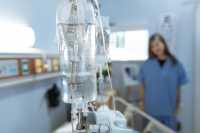 For many years now, professional nursing has held a unique place in the American health care system. Nurses make up one of the largest health care professions in the U.S. with more than 3.1 million nurses working in diverse fields and settings.
Although most nurses work in health care settings like hospitals, a nurse’s expertise expands well beyond the hospital walls. Working on their own and alongside other healthcare professionals, nurses promote the health of families, individuals, and communities.
Nurses have always played an important role in healthcare settings. However, their role has changed a lot over the years. In the past, nurses had extraordinarily little formal medical training. In fact, nurses learned the medical skills they needed from their mothers or other women in the nursing profession.
Today, the nursing profession has changed for the better. Not only are there extensive training programs available for nurses, but this role now comes with a level of prestige that was not there before. And this is not the only thing that has altered. Technology has also played a huge role in changing this profession for the better. Keep reading below to find out about the history of nursing and how technology has changed the role of nursing. For those seeking additional assistance or support in navigating the complexities of nursing education or academic tasks, exploring resources from reputable nursing paper writing services can offer valuable expertise and assistance in achieving success in the field.
For many years now, professional nursing has held a unique place in the American health care system. Nurses make up one of the largest health care professions in the U.S. with more than 3.1 million nurses working in diverse fields and settings.
Although most nurses work in health care settings like hospitals, a nurse’s expertise expands well beyond the hospital walls. Working on their own and alongside other healthcare professionals, nurses promote the health of families, individuals, and communities.
Nurses have always played an important role in healthcare settings. However, their role has changed a lot over the years. In the past, nurses had extraordinarily little formal medical training. In fact, nurses learned the medical skills they needed from their mothers or other women in the nursing profession.
Today, the nursing profession has changed for the better. Not only are there extensive training programs available for nurses, but this role now comes with a level of prestige that was not there before. And this is not the only thing that has altered. Technology has also played a huge role in changing this profession for the better. Keep reading below to find out about the history of nursing and how technology has changed the role of nursing. For those seeking additional assistance or support in navigating the complexities of nursing education or academic tasks, exploring resources from reputable nursing paper writing services can offer valuable expertise and assistance in achieving success in the field.
How Nursing Has Changed Over Time
Time has done a lot for many career paths. However, the nursing profession has seen more changes than most. Here are some of the ways the nursing profession has changed over time: Training – in the past, nurses were not required to have any formal education. However, nowadays nurses are no longer able to care for patients without passing the correct certification first. Setting – many years ago, nurses would take care of people in their homes or on the battlefield. Although some nurses still care for patients in their homes, nowadays, most nurses work in a hospital setting. Responsibilities – nursing responsibilities have come a long way from the early days when they used to look a lot like a household chore list. The change in responsibilities for nurses stems from several changes in the profession, including the changing views of women, more comprehensive training, and the growing demand for medical professionals. Culture – in the 20th century, nursing culture was known as being mainly made up of females who had a small amount of medical knowledge. While nursing culture has not changed completely, it has changed a lot over the years. In fact, research suggests that more men than ever are choosing to train in this profession. Patient care – patient care is more important than ever before. The advancements in technology have created an environment that makes patient care more helpful and efficient for patients. These advancements have altered almost every industry in the U.S. and the medical field is no different. (more…)
Author Interviews, Brigham & Women's - Harvard, Cost of Health Care, COVID -19 Coronavirus, Electronic Records, JAMA, Technology / 04.03.2021
Calling Dr. Spot: Robotic TeleDog Can Perform Key Hospital Tasks
MedicalResearch.com Interview with:
Carlo Giovanni Traverso, MB, BChir, PhD
Associate Physician, Brigham and Women's Hospital
Assistant Professor,
Peter R. Chai, MD, MMS
Emergency Medicine Physician and Medical Toxicologist
Harvard Medical School
Brigham and Women's Hospital
Department of Medicine
 MedicalResearch.com: What is the background for this study? What are some of the functions that Dr. Spot can facilitate?
Response: During the COVID-19 pandemic, we wanted to consider innovative methods to provide additional social distance for physicians evaluating low acuity individuals who may have COVID-19 disease in the emergency department. While other health systems had instituted processes like evaluating patients from outside of emergency department rooms or calling patients to obtain a history, we considered the use of a mobile robotic system in collaboration with Boston Dynamics to provide telemedicine triage on an agile platform that could be navigated around a busy emergency department. Dr. Spot was built with a camera system to help an operator navigate it through an emergency department into a patient room where an on-board tablet would permit face-to-face triage and assessment of individuals.
(more…)
MedicalResearch.com: What is the background for this study? What are some of the functions that Dr. Spot can facilitate?
Response: During the COVID-19 pandemic, we wanted to consider innovative methods to provide additional social distance for physicians evaluating low acuity individuals who may have COVID-19 disease in the emergency department. While other health systems had instituted processes like evaluating patients from outside of emergency department rooms or calling patients to obtain a history, we considered the use of a mobile robotic system in collaboration with Boston Dynamics to provide telemedicine triage on an agile platform that could be navigated around a busy emergency department. Dr. Spot was built with a camera system to help an operator navigate it through an emergency department into a patient room where an on-board tablet would permit face-to-face triage and assessment of individuals.
(more…)
 MedicalResearch.com: What is the background for this study? What are some of the functions that Dr. Spot can facilitate?
Response: During the COVID-19 pandemic, we wanted to consider innovative methods to provide additional social distance for physicians evaluating low acuity individuals who may have COVID-19 disease in the emergency department. While other health systems had instituted processes like evaluating patients from outside of emergency department rooms or calling patients to obtain a history, we considered the use of a mobile robotic system in collaboration with Boston Dynamics to provide telemedicine triage on an agile platform that could be navigated around a busy emergency department. Dr. Spot was built with a camera system to help an operator navigate it through an emergency department into a patient room where an on-board tablet would permit face-to-face triage and assessment of individuals.
(more…)
MedicalResearch.com: What is the background for this study? What are some of the functions that Dr. Spot can facilitate?
Response: During the COVID-19 pandemic, we wanted to consider innovative methods to provide additional social distance for physicians evaluating low acuity individuals who may have COVID-19 disease in the emergency department. While other health systems had instituted processes like evaluating patients from outside of emergency department rooms or calling patients to obtain a history, we considered the use of a mobile robotic system in collaboration with Boston Dynamics to provide telemedicine triage on an agile platform that could be navigated around a busy emergency department. Dr. Spot was built with a camera system to help an operator navigate it through an emergency department into a patient room where an on-board tablet would permit face-to-face triage and assessment of individuals.
(more…)
Author Interviews, Electronic Records, Race/Ethnic Diversity, Social Issues / 22.09.2020
Using the EMR to Identify Clinical Trial Candidates Can Increase Diversity in Studies
MedicalResearch.com Interview with:
Hailey Miller, PhD, RN
Postdoctoral Associate
Duke University School of Nursing
Stephen P. Juraschek, MD PhD
Beth Israel Deaconess Medical Center
MedicalResearch.com: What is the background for this study?
Response: Digital tools, such as the electronic medical record (EMR), are increasingly utilized to identify and recruit participants for clinical trials. These strategies offer a strong opportunity to increase recruitment yields, however, our previous work has demonstrated that patient portal users are disproportionately White, and therefore utilizing these strategies may contribute to the under-representation of Black Americans in clinical research.
This study examined multiple recruitment strategies, including EMR-based strategies and other non-EMR strategies, such as community mailing, Facebook advertisement and newspaper advertisement, to understand if recruitment strategies influenced the demographic composition of trial participants. Given our previous finding that patient portal users are disproportionately White, one of our EMR-based strategies included postal mailing to individuals without a patient portal.
(more…)
ASCO, Author Interviews, Cancer Research, Electronic Records / 30.05.2020
Cancer: Clinical Decision Support System Improved Compliance with Evidence-Based Treatment
MedicalResearch.com Interview with:
Debra A. Patt, MD, PhD, MBA, FASCO
Editor-in-chief of the Journal of Clinical Oncology - Clinical Cancer Informatics
Medical oncologist at Texas Oncology, and
US Oncology Research Breast Cancer Committee member
MedicalResearch.com: What is the background for this study?
Response: Cancer care is increasing in complexity with differentiation of cancer subtypes, new treatments, and treatment sequences and combinations. Complying with evidence based therapy has become an increasing challenge. We see that compliance with guideline based care across the country is highly variable.
Our study evaluated an electronic health record based Clinical Decision Support System to facilitate compliance with evidence based guidelines--or pathways--to deliver care to adult patients with cancer. (more…)
Author Interviews, Cost of Health Care, Electronic Records / 20.03.2020
Best Practice Alerts from Electronic Records Can Reduce Redundant Lab Testing
MedicalResearch.com Interview with:
Rohit Bishnoi, M.D.
Division of Hematology and Oncology
Department of Medicine
University of Florida
Gainesville, FL
MedicalResearch.com: What is the background for this study?
Response: National Healthcare expenditure was $3.6 trillion in 2018 and 17.7% of Gross Domestic Product. Redundant laboratory testing is one part of this problem that is more pronounced in hospitalized patients as they are often seen by multiple physicians from the time of admission till discharge. This added burden on the US health care system leads to increased costs, decreased patient satisfaction, and unnecessary phlebotomy. It also leads to iatrogenic anemia over time and unnecessary transfusions. The Choosing Wisely initiative recommendation from the Society of Hospital Medicine, Society for the Advancement of Blood Management, and the Critical Care Societies Collaborative have recommended avoiding repetitive labs.
As one of the physicians in the division of hospital medicine at the University of Florida (UF) Health Shands hospital, we encountered this problem frequently where a patient will get multiple HbA1c or lipid profiles or iron studies during the same hospital stay without any clear clinical indication. Most often these tests were ordered by different physicians seeing the same patient and not realizing that either the test has already been ordered or sometimes it is related to practice pattern of physicians. We often heard complaints about this from our nursing and laboratory staff and, most importantly by patients themselves. (more…)
Author Interviews, Compliance, Electronic Records, JAMA, University of Pennsylvania / 05.03.2020
How Best to Measure Patient Persistence with Medications? Self Report or Pharmacy Fill?
MedicalResearch.com Interview with:
Alexander C. Fanaroff, MD, MHS
Assistant Professor of Medicine, Division of Cardiovascular Medicine
University of Pennsylvania
MedicalResearch.com: What is the background for this study?
Response: This is a secondary analysis of the ARTEMIS, a cluster randomized trial of copayment assistance for P2Y12 inhibitors in patients that had myocardial infarction. One of the primary endpoints of ARTEMIS was persistence with P2Y12 inhibitors: Did the patient continue to take a P2Y12 inhibitor over the entire 1 year following MI? In ARTEMIS, we captured persistence data in two ways, patient report and pharmacy fill records. What we did in this study was to look at the agreement between persistence as measured by these two methods. (more…)
Abuse and Neglect, Electronic Records, Yale / 15.11.2019
Physicians Give Their Electronic Medical Records Systems an “F” for Usability
MedicalResearch.com Interview with:
Edward R. Melnick, MD, MHS
Assistant Professor of Emergency Medicine
Program Director, Yale-VA Clinical Informatics Fellowship Program
Principal Investigator, EMBED Trial Network
Yale School of Medicine
New Haven, CT 06519
MedicalResearch.com: What is the background for this study?
Response: We know that physicians are frustrated with their EHRs and that EHRs are a driver of burnout. This is the first study to measure these issues nationally.
We included a standardized metric of technology from other industries (System Usability Scale, SUS; range 0-100) on the AMA’s 2017 physician burnout survey. This metric has been used in >1300 other studies so we can compare where the EHR’s usability is to other everyday technologies. We are also able to measure the relationship between physicians’ perception of their EHR’s usability and the likelihood they are burned out.
(more…)
Allergies, Author Interviews, Electronic Records / 13.11.2019
False Penicillin Allergy Hard to Remove From Medical Records
MedicalResearch.com Interview with:
Sonam Sani MD
Allergy & Immunology Fellow
NYU Winthrop Hospital
MedicalResearch.com: What is the background for this study?
Response: Penicillin allergy label removal is becoming more common. Studies have shown that while 10% of the general population report an allergy to penicillin, after testing only 1% truly have an allergy. Allergists have the ability to evaluate patient’s for penicillin allergy by performing skin tests and oral challenges. However, even when people test negative for penicillin allergy, they still face barriers to having the label removed. We are noting more and more that despite having negative testing, upon further encounters, our patients still have their penicillin allergy label. (more…)
Annals Internal Medicine, Author Interviews, Electronic Records / 24.09.2019
When Hospital Data Systems Are Hacked, It’s Usually Financial Information That’s Leaked
MedicalResearch.com Interview with:
John (Xuefeng) Jiang PhD
Professor and Plante Moran Faculty Fellow
Eli Broad College of Business
Accounting & Information Systems
Michigan State University
East Lansing, MI
MedicalResearch.com: How did you get interested in this issue?
Response: This is the third project of our data breach trilogy. We first examined which healthcare providers (focusing on hospitals) more likely suffer from a data breach. We documented large hospitals, despite their resources, are more likely to experience a data breach. Some hospitals experienced multiple incidents (https://jamanetwork.altmetric.com/details/18464149).
The findings made us wonder what happened? Besides size, what other factors contribute to data breaches? Based on detailed event descriptions, we documented the circumstances under which each data breach occurred (https://jamanetwork.com/journals/jamainternalmedicine/article-abstract/2715158).
We found more than half of data breaches could be attributed to healthcare providers’ internal mistakes or negligence (e.g., forgot to encrypt laptop computers, used cc instead of bcc in emailing patients, didn’t revoke former employees’ login credentials after employment terminated) rather than external forces (e.g., hacking). We also found mobile devices (e.g. laptop computers, usb drives) are associated with most data breaches than paper records or network servers. Our results suggest if healthcare providers strengthen their internal control and limit the use of mobile device might be effective ways to reduce data breach risks.
(more…)
Author Interviews, Electronic Records, Emergency Care, JAMA / 19.09.2019
How Often Does Doctor’s Note Match What Happens in Exam Room?
MedicalResearch.com Interview with:
Carl Berdahl, MD, MS
Emergency Physician and Health Services Researcher
CEDARS-SINAI
West Hollywood CA
MedicalResearch.com: What is the background for this study?
Response: The length of a doctor’s note is taken account when determining how much a doctor or medical center is paid for a visit. However, in the digital era, a doctor can generate large amounts of text with just a few keystrokes. Given this incentive structure, we were concerned doctors’ notes might be inaccurate in certain sections of the chart that are important for billing. We used observers to determine how accurately doctors’ notes reflected the interactions between patients and physicians. (more…)
Author Interviews, Electronic Records / 02.07.2019
EHR Algorithms Overwhelm Physician Inboxes and Contribute to Burnout
MedicalResearch.com Interview with:
Ming Tai-Seale, PhD, MPH
Professor
Department of Family Medicine and Public Health
University of California San Diego School of Medicine
MedicalResearch.com: What is the background for this study?
Response: The electronic health record (EHR) potentially creates a 24/7 work environment for physicians. Its impact on physicians’ wellness has become a challenge for most health care delivery organizations. Understanding the relationships between physicians’ well-being and “desktop medicine”1 work in the EHR and work environment is critical if burnout is to be addressed more effectively.
(more…)
Author Interviews, Electronic Records, JAMA, Pediatrics, Primary Care / 07.05.2019
Pre-Visit Electronic Screening Helps Doctors Counsel Their Adolescent Patients
MedicalResearch.com Interview with:
Cari McCarty, PhD
Research Professor, UW
Investigator, Seattle Children’s Research Institute
MedicalResearch.com: What is the background for this study?
Response: Adolescence is a time when teens begin to take charge of their health, but it is also a time when they can be prone to health risk behaviors, such as insufficient physical activity, poor sleep, and substance use. We were interested in whether using an electronic health risk screening tool in primary care settings could improve healthcare and health for adolescents. The tool was designed to provide screening as well as motivational feedback directly to adolescents, in addition to clinical decision support for the healthcare clinician. We conducted a trial with 300 adolescent patients where one group received the screening tool prior to their health checkup, and the other group received usual care.
(more…)
Author Interviews, Compliance, Electronic Records, Lung Cancer, Race/Ethnic Diversity / 07.02.2019
Transparency and Technology Reduced Racial Disparities in Early Lung Cancer Treatment
MedicalResearch.com Interview with:
Samuel Cykert, MD
Professor of Medicine and Director of the Program on Health and Clinical Informatics
UNC School of Medicine, and
Associate Director for Medical Education, NC AHEC Program
Chapel Hill, NC
MedicalResearch.com: What is the background for this study? What are the main findings?
Response: Reports going as far back as the early 1990’s through reports published very recently show that Black patients with early stage, curable lung cancer are not treated with aggressive, curative treatments as often as White patients. These type of results have been shown in other cancers also. It’s particularly important for lung cancer because over 90% of these patients are dead within 4 years if left untreated. In 2010, our group published a study in the Journal of the American Medical Association that showed that Black patients who had poor perceptions of communication (with their provider), who did not understand their prognosis with vs. without treatment, and who did not have a regular source of care ( a primary care doctor) were much less likely to get curative surgery. Also our results suggested that physicians who treated lung cancer seemed less willing to take the risk of aggressive treatments in treating Black patients (who they did not identify with as well) who had other significant illnesses.
Because of the persisting disparities and our 2010 findings, we worked with a community group, the Greensboro Health Disparities Collaborative to consider potential solutions. As these omissions were not overt or intentional because of race on the part of the patients or doctors, we came up with the idea that we needed transparency to shine light on treatment that wasn’t progressing and better communication to ensure that patients were deciding on good information and not acting on mistrust or false beliefs. We also felt the need for accountability – the care teams needed to know how things were going with patients and they needed to know this according to race. To meet these specifications, we designed a system that received data from electronic health records about patients’ scheduled appointments and procedures. If a patient missed an appointment this umbrella system triggered a warning. When a warning was triggered, a nurse navigator trained specially on communication issues, re-engaged the patient to bring him/her back into care. In the system, we also programmed the timing of expected milestones in care, and if these treatment milestones were not reached in the designated time frame, a physician leader would re-engage the clinical team to consider the care options.
Using this system that combined transparency through technology, essentially our real time warning registry, and humans who were accountable for the triggered warnings, care improved for both Black and White patients and the treatment disparity for Black patients was dramatically reduced. In terms of the numbers, at baseline, before the intervention, 79% of White patients completed treatment compared to 69% of Black patients. For the group who received the intervention, the rate of completed treatment for White patients was 95% and for Black patients 96.5%. (more…)
Author Interviews, Electronic Records, Mental Health Research / 18.12.2018
Not All Electronic Health Record Warnings Are Accurate
MedicalResearch.com Interview with:
Katharine Phillips, M.D.
Professor of Psychiatry
DeWitt Wallace Senior Scholar
Residency Research Director
Department of Psychiatry
Weill Cornell Medical College, Cornell University
Attending Psychiatrist, New York-Presbyterian Hospital
Adjunct Professor of Psychiatry and Human Behavior
Alpert Medical School of Brown University
Weill Cornell Psychiatry Specialty Center
Weill Cornell Medicine I NewYork-Presbyterian
MedicalResearch.com: What is the background for this study? What are the main findings?
- Electronic prescribing of medication by clinicians is widespread; it is required in many institutions and in some states. Electronic prescribing systems commonly use computerized decision support algorithms that give prescribers automated warnings or alerts at the time of prescribing if the system identifies a potential prescribing error.
- Some prior studies suggest that electronic prescribing warnings/alerts may reduce prescribing errors and thus can be clinically useful. However, other prior studies caution that these alerts may have substantial limitations.
- Despite the importance of this topic, relatively few studies have examined the accuracy of automated prescribing warnings in electronic prescribing systems; to our knowledge, no prior study has focused primarily on prescribing of medications for psychiatric conditions.
- This report presents results from a survey of members of the American Society of Clinical Psychopharmacology (ASCP), a specialty society that advances the science and practice of clinical psychopharmacology, regarding automated warnings generated by electronic prescribing systems.

